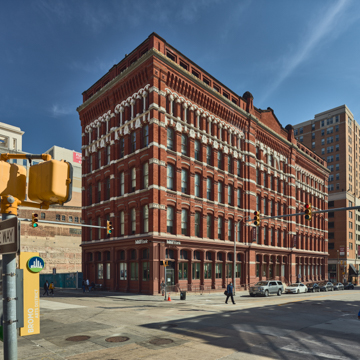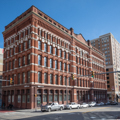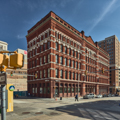Perhaps surprisingly, some of the most exuberant late-nineteenth-century buildings in Baltimore are the vertical manufactories and warehouses of the Loft District, and none better than the Italianate-influenced Abell Building. The attention to detail applied to these industrial buildings is noteworthy, reflecting their design by some of Baltimore’s best architects of the period. Considered among Frederick’s most successful works, the polychromatic building combines pressed brick, decorative corbeling, and terra-cotta, with lintels, Corinthian columns, and imposts in contrasting stone and marble. Likewise, it encompasses the city’s most extensive ornamental cast-iron street-level facade, manufactured by Bartlett, Robbins and Company of Baltimore. The Abell served as one of the city’s many vertical manufactories, producing ready-made clothing at a rate second only to New York City. Considered the best extant loft structure in the district, the building reflects Baltimore’s rise as a national industrial leader, from about 1870 to 1915. Others include the Inner Harbor Lofts I, formerly the Heiser (1886), the Rosenfeld (1905), and the Strauss (1887) buildings at 32–42 S. Paca Street that together form a microcosm of industrial loft design as it appeared in Baltimore, reflecting Richardsonian Romanesque, High Victorian Gothic, and Beaux-Arts classical styles.
You are here
ABELL BUILDING
If SAH Archipedia has been useful to you, please consider supporting it.
SAH Archipedia tells the story of the United States through its buildings, landscapes, and cities. This freely available resource empowers the public with authoritative knowledge that deepens their understanding and appreciation of the built environment. But the Society of Architectural Historians, which created SAH Archipedia with University of Virginia Press, needs your support to maintain the high-caliber research, writing, photography, cartography, editing, design, and programming that make SAH Archipedia a trusted online resource available to all who value the history of place, heritage tourism, and learning.





